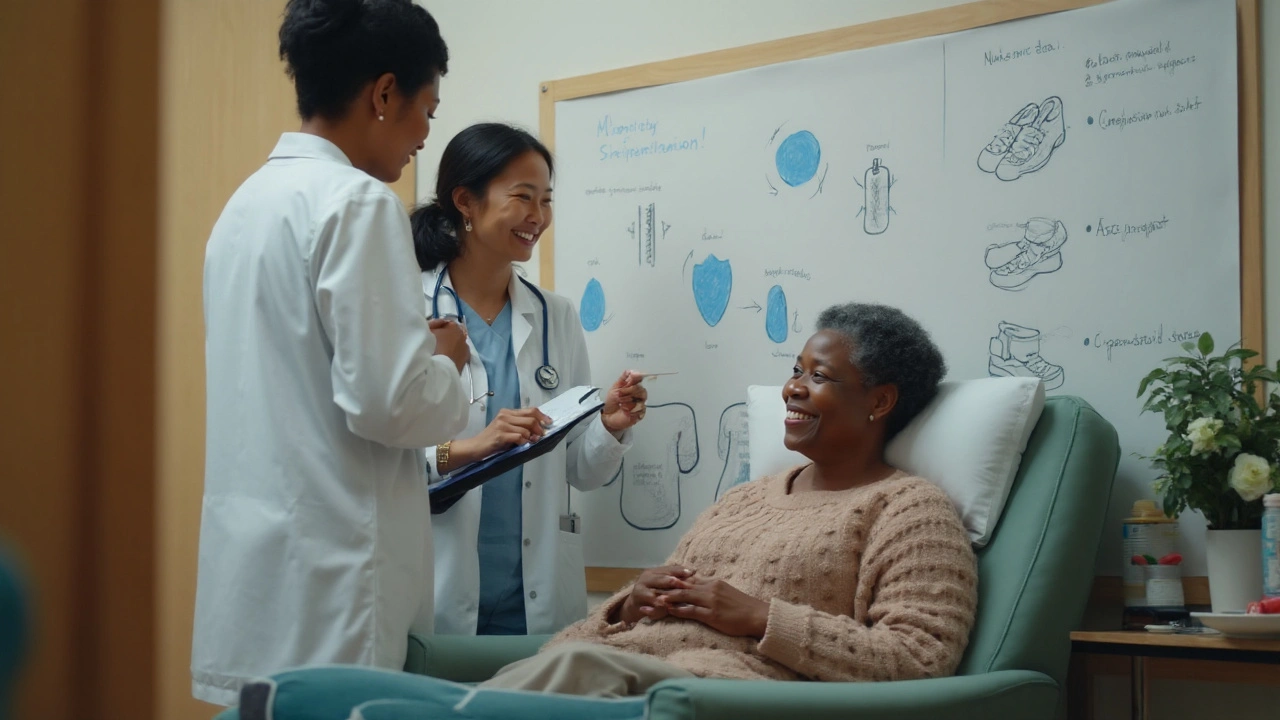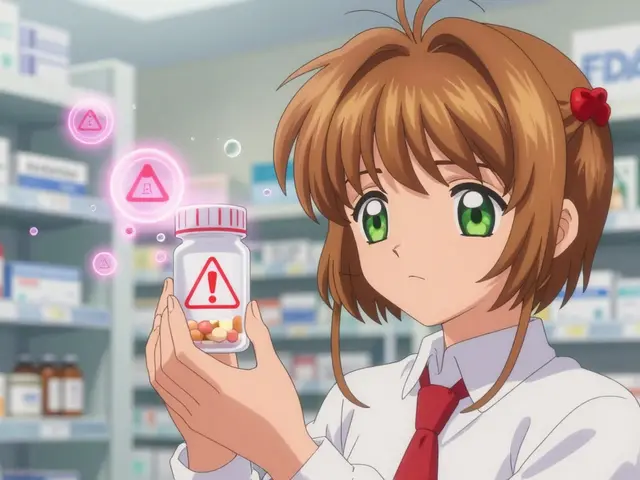Broken bones on dialysis are not rare. Hip fracture risk is about 3-4 times higher than in the general population, and recovery is harder. The good news: you can cut that risk with steady lab control, smart food choices, and the right meds. This guide shows what causes renal bone disease, what to watch, and how to act without guesswork.
- TL;DR: Dialysis-related bone disease comes from a calcium-phosphate-PTH imbalance. Aim for phosphate near normal, avoid high calcium, and keep PTH in a safe range.
- Prevention is daily: binders with meals, dialyze as prescribed, pick lower-phosphate foods, take vitamin D or calcimimetics if advised.
- Treatment is tailored: high-turnover disease needs PTH-lowering; low-turnover disease needs you to avoid oversuppression.
- Falls prevention matters as much as lab targets. Strong legs and a safe home save hips.
- Decisions should track trends, not single labs. Monthly phosphate and calcium; PTH every 1-3 months in dialysis.
What it is and why it happens on dialysis
Renal osteodystrophy is the bone part of CKD-MBD, the mineral and bone disorder that comes with chronic kidney disease. When kidneys falter, phosphate builds up, vitamin D activation drops, calcium drifts, and parathyroid glands pump out more PTH. That hormonal storm changes how bone turns over and mineralizes. In dialysis, the problem rarely disappears without active management.
You will see two main patterns on bone turnover:
- High-turnover (secondary hyperparathyroidism): PTH is high. Bone remodels too fast, becomes weak and achy, and releases calcium and phosphate back into blood.
- Low-turnover (adynamic bone): PTH is too low or over-suppressed. Bone barely remodels, can become brittle, and calcium can drift high, especially with high-calcium dialysate or heavy calcium-based binders.
The aim is balance: enough turnover to repair microdamage, not so much that bone quality crumbles. Think of it like braking downhill: not full throttle, not full stop.
Why dialysis patients are at risk:
- Phosphate removal is imperfect. Food additives add stealth phosphate that binders miss if not timed right.
- Dialysate calcium concentration nudges calcium balance up or down with every treatment.
- Vitamin D activation drops when kidneys fail, so calcium absorption falls unless replaced.
- Parathyroid glands can become enlarged and less responsive over years of CKD.
In plain language: if phosphate runs high and vitamin D stays low, PTH rises to pull calcium from bone. If you later slam PTH too low with aggressive therapy, bone starves for turnover. You want the middle path. That is the heart of renal osteodystrophy care.
KDIGO CKD-MBD Guideline (2017): manage phosphate, calcium, and PTH together using serial measurements; avoid chasing a single number in isolation. Source: Kidney Disease: Improving Global Outcomes, CKD-MBD guideline update 2017.
How to spot it and track it: symptoms, labs, and diagnosis
You can’t feel a PTH level, but you can notice clues. Here is what tends to show up.
Symptoms and signs to raise suspicion:
- Deep bone pain (hips, ribs, shins), muscle weakness, or thigh pain when standing
- Itching that worsens with high phosphate
- Fragile nails or dental issues
- Spontaneous tendon rupture or calcified vessels on imaging (advanced cases)
Key labs and what they mean (Canadian SI units first, US units in brackets):
- Phosphate: 0.8-1.5 mmol/L (2.5-4.6 mg/dL) is a common dialysis goal; trends matter
- Corrected calcium: keep in normal range; avoid persistent high values
- PTH (intact): in dialysis, aim roughly 2-9 times the assay upper limit
- Alkaline phosphatase: a surrogate for bone turnover; rising levels suggest high turnover
- 25-OH vitamin D: replenish if deficient
Imaging and tools:
- DEXA scan: checks bone density; helps fracture risk talk, but it doesn’t reveal turnover pattern
- Plain X-rays: may show vascular or soft tissue calcifications if calcium-phosphate product has been high
- Bone biopsy: gold standard for turnover and mineralization; reserved for unclear cases where treatment hinges on the answer
Testing rhythm that works in dialysis:
- Monthly: phosphate, corrected calcium, alkaline phosphatase
- Every 1-3 months: PTH (closer to monthly if changing therapy)
- Every 6-12 months: 25-OH vitamin D; repeat DEXA every 1-2 years if results would change care
When to suspect high-turnover disease:
- PTH persistently high with bone pain, pruritus, high alkaline phosphatase
- Phosphate hard to control despite binders and dialysis
When to suspect low-turnover disease:
- PTH persistently low or falling fast after aggressive therapy
- Normal to high calcium with low alkaline phosphatase and fatigue or fractures from minimal trauma
| Marker | Practical target in dialysis | Actions if high | Actions if low |
|---|---|---|---|
| Phosphate | Near normal (0.8-1.5 mmol/L; 2.5-4.6 mg/dL) | Increase binders; choose non-calcium binders; tighten diet; consider longer or more efficient dialysis | Check nutrition; adjust binders down; review dialysis removal |
| Corrected calcium | Normal range; avoid chronic high | Lower calcium dialysate; cut calcium-based binders; watch vitamin D dose | Check albumin, magnesium; ensure vitamin D replacement |
| PTH (intact) | About 2-9× ULN for assay | Calcimimetic; vitamin D analog cautiously; reduce calcium dialysate | Reduce vitamin D/calcium load; consider raising dialysate calcium only if symptomatic and supervised |
| Alkaline phosphatase | Stable; not rapidly rising | Look for high turnover; manage as above | Consider low turnover; avoid oversuppression |

Prevention that works: food, binders, dialysis, daily habits
Prevention is the quiet work that drops fracture risk. Small wins stack up. Here is the practical playbook.
Food choices that move the needle:
- Spot phosphate additives: look for words with ‘phos’ on labels (sodium phosphate, pyrophosphate). Additive phosphate absorbs easily; it spikes labs.
- Favor whole proteins over processed ones: chicken thigh you cook beats deli slices; real cheese beats processed slices.
- Pick lower-phosphate dairy patterns: smaller portions; spread them out; mind binder timing.
- Beans and nuts are nutrient-dense; portion them and pair with binders if they fit your plan.
Binder basics that actually work:
- Take binders with the first bite of meals or snacks that contain phosphate. They do not work if taken long after eating.
- Match binder dose to meal size and phosphate load. A big takeout meal needs more than a small bowl of oats.
- Common options: calcium-based binders; sevelamer; lanthanum; iron-based agents. Your team picks based on calcium level, pill burden, gut tolerance, and anemia status.
- Side effects to watch: constipation or bloating (sevelamer can cause GI upset); high calcium with calcium-based binders; dark stools with iron-based agents.
Dialysis matters more than you think:
- Show up and finish every minute. Shortening sessions raises phosphate.
- Longer or more frequent dialysis removes more phosphate. Nocturnal in-center or home hemodialysis can normalize phosphate with fewer binders for some.
- Peritoneal dialysis removes phosphate steadily but sometimes not enough; binder adherence is key.
Vitamin D and calcium done right:
- Cholecalciferol (D3) or ergocalciferol (D2) to fix low 25-OH vitamin D
- Active vitamin D analogs (calcitriol, alfacalcidol, paricalcitol) if PTH is high and calcium/phosphate allow
- Watch for rising calcium or phosphate after starting active vitamin D; adjust promptly
Strength and falls prevention:
- Two to three sessions weekly of leg and core strength work: sit-to-stands, step-ups, resistance bands
- Balance drills: heel-to-toe walk, single-leg stands by a counter
- Home tweaks: remove loose rugs, add grab bars, check lighting, wear non-slip footwear
- Ask about a falls risk check if you have neuropathy, vision changes, or dizzy spells
Medication interactions to remember:
- Space binders from some meds: separate from levothyroxine and some antibiotics by at least 2-4 hours
- Tell your pharmacist you use phosphate binders; they can spot clashes
Quick prevention checklist you can print:
- Binder with every phosphate-containing meal/snack
- Read labels for words with ‘phos’
- Do not skip or shorten dialysis
- Take vitamin D as prescribed; recheck levels
- Two strength sessions weekly; remove fall hazards at home
- Bring your food log and meds to clinic; ask for a binder dose check-in
Treatment playbook: targets, meds, decisions, and what-ifs
If prevention is daily habit, treatment is targeted course correction. Here is how teams usually steer care, and how you can follow the logic.
Set the targets first:
- Phosphate: keep near normal; do not accept chronic high values
- Calcium: keep in normal range; avoid persistent highs
- PTH: in dialysis, keep about 2-9 times the lab upper limit; avoid extremes
When phosphate is high:
- Confirm binder timing and dose; shift toward non-calcium binders if calcium is high or borderline
- Review diet for additives; swap processed foods for whole-food protein
- Check dialysis dose and adherence; consider longer sessions or higher efficiency if feasible
- Recheck in 2-4 weeks; adjust early rather than waiting months
When PTH is high with acceptable calcium/phosphate:
- Active vitamin D analogs can lower PTH and help bone. Start low, watch calcium and phosphate.
- Calcimimetics (cinacalcet by mouth or etelcalcetide IV) lower PTH by sensitizing the parathyroid to calcium. They can cause low calcium and nausea; labs need close watch.
- If glands are very enlarged and meds fail, surgical parathyroidectomy is an option. It needs planning to avoid hungry bone syndrome afterward.
When PTH is low (possible low-turnover bone):
- Back off the suppression: reduce or stop calcimimetic and active vitamin D if safe
- Limit calcium load: switch to non-calcium binders; consider adjusting dialysate calcium
- Ask your team if a bone biopsy is needed before starting any antiresorptive osteoporosis drug
Osteoporosis drugs in dialysis: use carefully
- Bisphosphonates can help in high-turnover bone but may harm in low-turnover; kidney clearance and rare jaw issues are concerns
- Denosumab is not renally cleared but can cause severe low calcium in dialysis; you need tight calcium/vitamin D support and plan
- Teriparatide stimulates turnover; consider only in proven low-turnover after expert review
Simple decision path you can discuss with your team:
- Check trends in phosphate, corrected calcium, PTH, alkaline phosphatase
- If phosphate is high: fix food + binder + dialysis first
- If PTH is still high and calcium/phosphate allow: add active vitamin D; if calcium is high or you want stronger PTH control, add a calcimimetic
- If PTH is low or falling too fast: ease off suppressive therapies; limit calcium load
- Suspect low-turnover or mixed disease? Consider bone biopsy before osteoporosis drugs
Side-effect watchlist and fixes:
- Nausea on cinacalcet: take with food; dose-split; ask about switching to IV etelcalcetide
- Constipation on binders: add fiber you can tolerate, gentle laxatives if needed, or switch binder class
- Itch with high phosphate: tighten binders and diet; consider gabapentin or difelikefalin if offered
- Low calcium after calcimimetic: adjust dose; add calcium briefly if advised; check magnesium and vitamin D
Questions people ask a lot (mini‑FAQ):
- Can diet alone fix high phosphate on dialysis? Usually not. Most people need binders plus food changes and full dialysis time.
- Is calcium in food bad? Not by itself. The problem is excess calcium from high-calcium binders or dialysate when PTH is low. Food calcium in normal portions is fine for most.
- Do I need a bone biopsy? Only if the answer changes treatment, like before starting certain osteoporosis drugs when turnover status is unclear.
- Will a transplant reverse bone disease? Often it helps. PTH and phosphate can normalize over months, but long-standing gland growth may take time or surgery.
- Are plant-based proteins okay? Yes, with planning. Plant phosphate is less absorbed. Work with your renal dietitian to hit protein targets.
Next steps you can take this week:
- Bring your last three months of labs to clinic; ask how close you are to the targets above
- Open your cupboard and flag any product with words ending in ‘phos’
- Match a binder dose to each regular meal; set reminders on your phone
- Add two short strength sessions to your week; put them on the calendar
- Ask whether your current dialysate calcium fits your lab pattern
When to escalate or troubleshoot:
- PTH stays above target despite adherence: confirm pill counts, binder type, vitamin D status, and adequacy of dialysis; discuss adding a calcimimetic or switching classes
- Calcium creeps high with low PTH: peel back calcium-based binders and active vitamin D; reassess dialysate calcium
- Frequent falls or a new fragility fracture: get a falls risk review, DEXA, and, if needed, a turnover assessment before bone drugs
Credible guidance you can trust: KDIGO CKD-MBD (2017) underpins most targets; National Kidney Foundation and Canadian Society of Nephrology echo similar principles. Large registries like the US Renal Data System report the higher fracture risk in dialysis, which is why steady prevention matters.








12 Comments
Clay Johnson
August 31, 2025 AT 16:52Phosphate isn't just a number. It's the ghost in the machine of bone metabolism. Every binder, every dialysis session, every slice of processed cheese-it's a tiny negotiation between your body and the failing kidneys. You don't cure renal osteodystrophy. You negotiate it daily.
There's no magic pill. Just discipline. And the quiet realization that your bones are the ledger where every dietary misstep gets recorded.
Turnover isn't binary. It's a spectrum. And the worst mistake is treating it like a switch instead of a dimmer.
When PTH drops too fast, you don't get healthy bone. You get brittle stone. And no one tells you that until your hip fractures on a sidewalk.
Calcium isn't the villain. It's the bystander. The real villain is the unexamined assumption that normal labs equal healthy bone.
Bone biopsy isn't exotic. It's the only way to know if you're treating the disease or the lab report.
Transplant doesn't fix bone. It just gives you a new chance to get it right.
Stop chasing targets. Start observing trends.
And for god's sake, stop eating things with 'phos' in the ingredients list. That's not food. That's chemical warfare.
The system isn't broken. You're just trying to win a game where the rules change every month.
It's not about control. It's about coexistence.
Jermaine Jordan
September 1, 2025 AT 09:05THIS IS LIFE-ALTERING INFORMATION. If you're on dialysis and not acting on this, you're gambling with your skeleton.
Every single point here-from binder timing to falls prevention-is a potential lifeline.
Stop treating your bones like an afterthought. They're the foundation. Without them, everything else crumbles.
Take this guide. Print it. Tape it to your fridge. Share it with your care team.
This isn't medical jargon. This is survival.
Thank you for writing this. Someone needed to say it clearly.
Chetan Chauhan
September 2, 2025 AT 10:02phosphate is not the enemy bro. its the dialysis machine that's broken. they just wanna keep you hooked on binders so they can bill more.
my uncle had low pth and they gave him more calcimimetic and he got hypocalcemic and nearly died. the system is rigged.
why dont they just fix the kidneys instead of patching bones? ask yourself that.
Phil Thornton
September 2, 2025 AT 17:43Binders with meals. Not after. Not before. WITH.
Strength twice a week. Not someday. Now.
Read labels. No 'phos'.
That's it. That's the whole guide.
Do those three things and you're already ahead of 80% of patients.
Pranab Daulagupu
September 4, 2025 AT 07:52This is exactly the kind of clarity the CKD-MBD space needs. The balance between suppression and turnover is so nuanced, yet so critical.
Most providers focus on PTH in isolation. But alkaline phosphatase? That’s the silent sentinel.
And the falls prevention section? Pure gold. Bone health isn’t just labs-it’s mobility, lighting, rugs, grip strength.
Thank you for framing this as a daily practice, not a medical checklist.
Barbara McClelland
September 4, 2025 AT 15:14Okay, real talk-this guide just made me feel less alone.
I’ve been terrified of my own bones for years. I thought if I just ate less dairy, I’d be fine. Turns out, it’s way more complex.
But now I know what to ask my nephrologist. And I’m starting my sit-to-stands tomorrow. Right after breakfast. With my binder.
You don’t have to be perfect. You just have to show up.
And if you’re reading this and you’re scared? You’re not alone. We’re in this together.
Alexander Levin
September 5, 2025 AT 19:19They say 'phosphate binders' but they're really just selling you calcium to fix what they broke.
Ever wonder why the same drugs that lower PTH also make you vomit? Coincidence? I think not.
They want you dependent. On binders. On dialysis. On fear.
Check your dialysate calcium. It's probably set too high. Ask why.
And don't trust 'KDIGO'. They're funded by pharma.
Bone biopsy? More like a cash grab.
Wake up.
💀
Ady Young
September 7, 2025 AT 14:03Clay’s comment about coexistence hit me hard. I’ve been fighting my body for years. This isn’t a battle-it’s a partnership.
I started taking binders with every meal last week. Didn’t think it’d make a difference. My phosphate dropped 0.3 mmol/L in three weeks.
Also, I did my first set of resistance bands yesterday. My legs didn’t shake. That felt like a win.
Thanks for the practical checklist. I printed it. I’m keeping it by my coffee mug.
Travis Freeman
September 9, 2025 AT 11:57As someone who moved from India to the US for dialysis, I can say this: the care here is advanced, but the emotional weight? That’s universal.
This guide didn’t just give me info. It gave me permission to be patient with myself.
My mom back home used to say, 'A healthy bone is a quiet bone.' She didn’t know the science. But she knew truth.
Keep sharing this. It helps more than you know.
Sean Slevin
September 10, 2025 AT 20:33Let’s be real: the entire CKD-MBD paradigm is built on a flawed assumption-that bone turnover can be 'managed' like a thermostat.
But bone isn’t a machine. It’s a living, breathing, slowly dying tissue that’s been starved of oxygen, vitamin D, and dignity for years.
And we’re treating it with pill schedules and lab ranges?
What if the real solution isn’t more binders-but less dialysis? More transplants? More research into regenerative pathways?
We’re bandaging a hemorrhage and calling it prevention.
And yes-I typed this with three typos. Because I’m tired. And so are my bones.
Chris Taylor
September 10, 2025 AT 21:27I’ve been on dialysis for 7 years. This is the first time I’ve read something that didn’t make me feel like a problem to be fixed.
It just… explained it.
Thanks.
Melissa Michaels
September 12, 2025 AT 13:31Excellent synthesis of KDIGO guidelines with clinical nuance. The emphasis on alkaline phosphatase as a turnover marker is underutilized in practice.
One critical omission: the role of magnesium in modulating PTH secretion and calcium handling. Consider supplementing if low, particularly in patients on high-dose calcium-based binders.
Also, remind patients that vitamin D deficiency is not just a lab value-it’s a functional impairment in intestinal calcium absorption.
Well done.